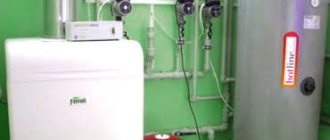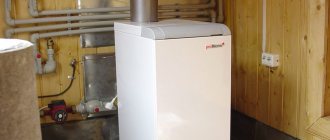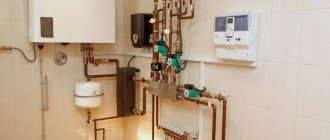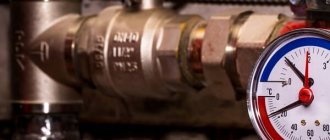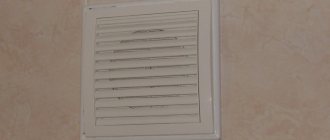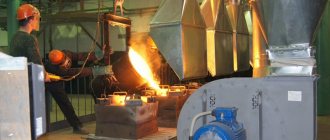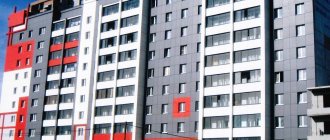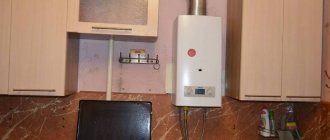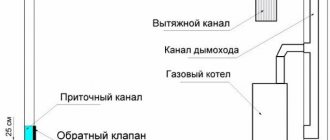Any room in which a swimming pool is located is quite specific, mainly due to the abundance of water vapor. As you know, moisture settles in the form of condensation on colder surfaces, as a result of which corrosion processes develop, fungus and rot appear. In addition, the windows in this room fog up, and moisture settles on almost everything located there. To avoid such troubles, you will need high-quality pool ventilation. What it is, why it is needed and how it is arranged will be discussed in today’s article.
Pool ventilation
- 1 Why may pool ventilation be required?
- 2 Option one. With separation of outflow/inflow of air 2.1 Video - About ventilation in swimming pools
- 7.1 Video – Installation of a supply and exhaust ventilation system
Why may pool ventilation be required?
Due to the special characteristics of the air and water in the room where the swimming pond is located, moisture safely evaporates from the bowl, and it is not possible to interfere with this process. When moisture settles on various kinds of structural elements or simply interior items, it inevitably leads to their deterioration. However, if you properly design and equip the ventilation system, it will effectively remove all air fumes to the street.

Another disadvantage of the abundance of water vapor indoors is that people who swim in the pool simply experience discomfort. Moreover, humid air negatively affects the respiratory system, as well as the psychological state of a person as a whole. And finally, the third reason why ventilation is mandatory in this case is the inevitable damage to all electronic equipment located in the pool. Typically, even ceiling lighting fixtures protected by glass become unusable.

To make the ventilation system more efficient, it is usually additionally equipped with air dryers. By the way, there are many ventilation systems themselves, but only two are the most popular among them:
- with separation of outflow/inflow of air;
- supply and exhaust (with heat recovery option).
Let's take a closer look at each of the options mentioned.

Installation of ventilation for private pools in cottages
You can often see cottages with swimming pools outside the city. Such baths are designed for a maximum of 5-7 people. As a rule, a swimming pool is built for one family and guests coming to the house. In a private house it is designed according to an individual plan. All wishes of the owner are taken into account. The main task when creating a project is the reality of bringing it to life and the safety of installing a pool, both for the home and for the owners.
Options:
- The swimming pool is located on the ground floor of the cottage.
- Heating is installed around the perimeter of the hall.
- 18-50 m² – average area.
- 4-6 m – average depth.
- 3 m – the width of the paths around the pool.
The use of a swimming pool in a private cottage can be permanent, seasonal or periodic.
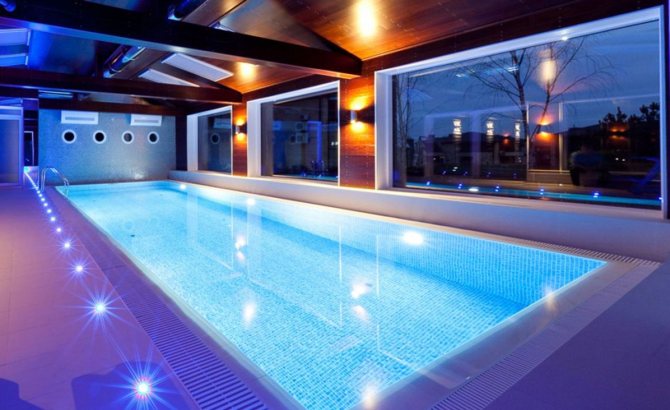
Option one. With separation of outflow/inflow of air
This type of ventilation system is classified as separate; in this case, the air enters and exits through separate system elements. If we talk about cost, then equipment for such ventilation is noticeably cheaper (when compared with the option described in the next paragraph of the article), however, during further operation it will necessarily require considerable expenses. In addition, the dimensions of the separate ventilation system are quite large, therefore, using it (especially in small rooms) is very inconvenient.

Note! The supply ventilation of the pool has one very important distinctive feature - it supplies fresh air into the room separately from the parallel exhaust of air that has managed to be humidified to the street.
We also note that such ventilation systems are often equipped during the construction of swimming pools. The main element in this case is the fan, which is built into the exhaust ducts.
If we talk specifically about the flow of fresh air, it is carried out through the following devices:
- a control unit designed to maintain the volume of supplied air and temperature;
- an air intake device on which there is a valve that does not allow cold outside air to enter the room in cases where the system is turned off;
- a fan with which air is pumped in;
- a cleaning filter necessary to clean the incoming air;
- a heating device with which this incoming air is heated.
For a more detailed understanding of this issue, we recommend watching the thematic video presented below.
Video - About ventilation in swimming pools
In what cases is it necessary to install climate control systems?
Climate control systems are large-sized equipment designed to maintain an optimal microclimate throughout the year, that is, both in the cold season and in the warm period. They are installed in pools with an area of more than 100 m².
Tasks of the complexes:
- Air cleaning.
- Drying.
- Heating the air.
- Air circulation.
Components of the climate complex:
- Supply fan.
- Exhaust fan.
- Recuperator.
- Dehumidifier.
- Filters.
- Heater.
- Air valves.
- Control block.
We recommend that you read: Do-it-yourself natural ventilation system in a private house
A separate room next to the pool is allocated for equipment. Installation is usually carried out in the basement or adjacent utility room. The possibility of using climate control systems in each specific case must be calculated based on the size of the room.
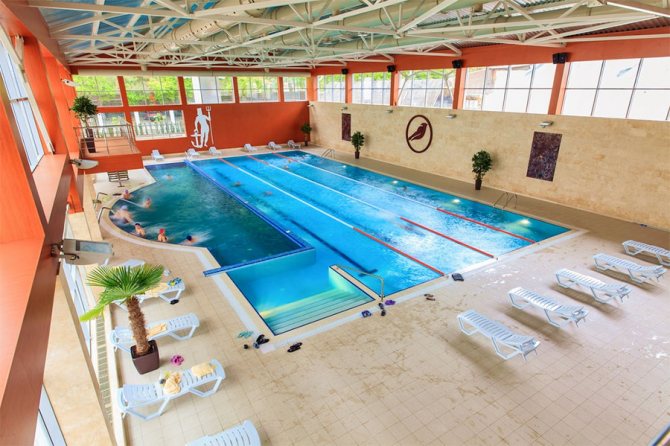
Option two. Supply and exhaust (with heat recovery function)
If we talk about this type of exhaust ventilation system, then it functions in a single unit. Typically, such a system will require serious expenses even during the purchase of all the equipment required for it, but during further operation you will encounter a pleasant surprise - noticeable savings (much greater than that of the option described above).

Let's get acquainted with the main advantages of using such systems.
- First of all, its installation does not require too much space. One block contains all the components necessary for the operation of the system, therefore, the entire complex turns out to be very oversized when compared with ventilation, in which the elements are separated. An ideal option for pools whose area is small, which means they are most often used in private country houses.
- Another advantage is that during operation the system does not consume much electricity, since it (as the name suggests) has a recuperator. Thanks to this device, you can save from 50 to 40 percent of electricity, since the supply air is heated by the exhaust gas, but does not mix with it. In other words, the temperature in the room is kept at the same level only thanks to its thermal reserve. And this, in turn, reduces the required power of the motor used by approximately two or two and a half times.

As for the design of the supply and exhaust system, it includes the following important elements:
- heater of air entering inside;
- fan (still the same supply and exhaust);
- heat recuperator;
- purification filter necessary to purify fresh air;
- the last element is a double valve, with which the cold air supply is shut off if the system is turned off.

We also note that the system described above, equipped with a heat recuperator, is quite often also equipped with a function for automatically adjusting temperature indicators, as well as the values of the amount of water vapor. Moreover, this pool ventilation can additionally be equipped with devices that distribute heated air to other rooms; Another example of a “bonus” device is a dehumidifier.
Calculation of the amount of evaporated moisture
If you calculate the amount of moisture that enters the surrounding air in 1 hour, you can determine the volume of supply air and the required dehumidifier power for a particular room. This can be done by calculating the pressure difference multiplied by the evaporation rate factor. But this method is quite complex and requires extraordinary knowledge of physics.
We will not bother you with difficult-to-pronounce terms that are used in calculations. The most important thing you need to know is: the planned temperature of water and air in the room, and its utilization rate. This is the variable value on which the amount of moisture evaporated by the pool directly depends. The rest of the data can be found in special tables.
Ventilation in a swimming pool - example of calculation. An indoor pool in a private house, as a rule, will have this coefficient equal to 0.5 - 1, while in a water park pool, with people actively swimming throughout the day, the coefficient will already be 25-30. The larger the area of water, the more intense the evaporation. And the presence of waves from actively swimming people increases the area of contact between water and air.
But you shouldn’t worry too much about such difficulties. Based on many years of experience of many ventilation design companies, we can authoritatively state that for most swimming pools in private homes, this figure varies between 200 - 300 g/m2, subject to standard air and water temperatures, as well as indoor humidity. Now everything is simple: Knowing this value, it is multiplied by the area of the pool. As a result, we have the first part of the data for constructing effective ventilation.
But we must not forget about the power of the supply air, which is necessary to maintain a comfortable level of humidity in the room. In order to obtain inflow data, you need to know several parameters:
- The amount of moisture evaporated in the room.
- Moisture content in the air (outdoors).
- Specific density of air at the planned temperature in the pool room.
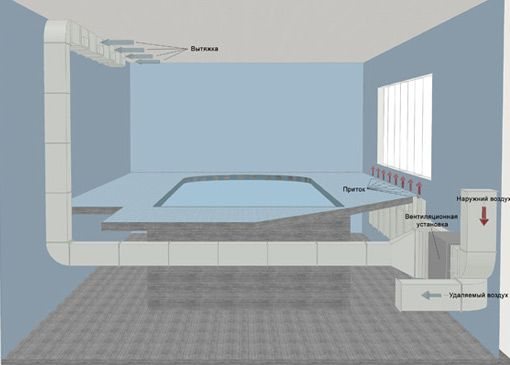
But humidity can be a problem as it changes depending on the time of year and weather conditions. Most companies involved in such calculations use an average value of moisture content in the ambient air of 9 g/kg. Then everything is calculated using the formula: the amount of moisture evaporated by the pool is divided by the difference in water content in the indoor and outdoor air, and multiplied by the air density. The resulting figure will be key when selecting equipment power and constructing ventilation in a private house with a swimming pool.
Ventilation in the pool, the calculation of which we showed you, will be most effective if professionals receive and analyze the data. Believe me, we told this solely so that you understand how this all happens and what companies that design ventilation systems charge for. In fact, they use about a dozen other different data, rather complex equipment and expensive software, thanks to which they obtain the most accurate result.
Independent arrangement of the pool with supply and exhaust equipment
If you decide to start arranging ventilation for the pool yourself, then you need to know a few basic rules for air exchange in these rooms:
- Hoods are best placed at the top of the room, as moist and warm air rises.
- Use vents large enough to ensure good recirculation air velocity.
- Do not place ventilation grilles at the bottom of the pool. This placement may make you feel uncomfortable.
In addition, when arranging ventilation for a swimming pool in a cottage, you need to understand its components. First of all, this is a supply and exhaust fan with the power required for your room. You will also need: a certain number of boxes of the required cross-section for air exhaust and supply, a filter to remove mechanical impurities. For high-quality operation of the ventilation system, you will need a double supply valve and a device such as a “recuperator”, which will help you use thermal energy most efficiently.
And finally: If you listened to our advice and still gave your preference to ducted supply and exhaust devices, then pay attention to installations produced under the Calorex and Dantherm brands. These are companies that produce the most modern supply and exhaust ventilation devices with a built-in heat recovery unit for swimming pools of any size.
And remember that well-designed ventilation will protect you from many health problems, high energy costs, and will give you the opportunity to enjoy full-fledged active recreation in your own pool for many years. Contact the specialists!
What about automated ventilation systems?

Automatic systems are capable of monitoring the entire ventilation system, as well as adjusting its functions. Below are the main points that automated systems perform.
- Direct connection of the ventilation system with the so-called “smart home” system.
- Maintaining air temperature and humidity levels at the required level, monitoring the performance of the ventilation system itself.
- Providing protection (both for the system as a whole and its individual components), preventing water from freezing in water heaters, reducing voltage, and so on.
- Notification of all problems and emergency situations that occur in the system.
- Monitoring the sequence of all operations that occur in the system.

As you can see, there are really a lot of functions, and therefore automated systems fully justify their inflated cost.

Additional points
If ventilation is designed independently, then any standard calculation must contain several computational operations. The main ones are:
- Calculation of sensible heat. This heat means the temperature of the heating devices, the body temperature of the person in the pool, the temperature of all heaters, etc.
- Moisture entering the external environment. This is moisture that comes from a person, the pool itself, or from the bypass paths. You can't lose sight of any parameter. After all, this may negatively affect all subsequent calculations.
- Heat transfer is calculated based on the parameters of humidity and sensible heat. This value is compared with the standards, which are located in a special table. Based on the obtained value, the parameter for the pool is selected.
So, there is nothing complicated in the calculations. They allow you to correctly and quickly calculate all the parameters necessary for drawing up a project. Based on clarification of the results, you can make adjustments to the project at any time.
For example, it may not initially involve the use of powerful equipment. If the calculations yield ambiguous results, then adjustments can be made to the equipment. You can always install an additional cooling system for water and a heating device for heating in winter.
Universal tables are created that, based on the initial values, will help you select any device options. This is very important both at the design stage and at the implementation stage of a finished ventilation system.
Regulatory Requirements
Any ventilation system must be selected in accordance with certain indicators that must be observed in the premises where swimming pools are located. If you intend to provide the most safe and comfortable conditions in the mentioned premises, then you must adhere to some numbers.
- The maximum air humidity should be 65 percent.
- The air exchange rate, in accordance with regulatory requirements, is equal to 80 cubic meters per hour for each person in the room. Although when drawing up a project, as a rule, they are not based on this indicator, but on the calculated value.
- The maximum difference between the temperature indicators of water and air should be no more than 20 degrees (and exclusively in favor of air).
- The gas flow that exits the ventilation system must have a speed of no more than 20 meters per second. If the speed is higher, drafts will form that can be felt by the skin.
- Finally, the water temperature, in accordance with the same standards, must be less than 32 degrees Celsius.

Note also that regulatory requirements allow a difference between the volumes of outgoing/incoming air, but no more than ? total air exchange rate. Although in this case you must definitely take into account the speed at which the gas flow moves. When designing, take into account the fact that the noise level in a given room is - it should be a maximum of 60 decibels.
Note! It is quite obvious that the natural ventilation system is unable to provide such indicators in a room, and therefore, if there is a swimming pool, it (the room) must be equipped with forced ventilation.

Existing norms of parameters
When creating ventilation in the swimming pool of a private house, the following environmental factors must be taken into account:
- air humidity no more than 65%;
- air temperature that will not differ from the water temperature in the pool by more than 2°;
- the water temperature should not be higher than 32°;
- the air movement speed should not be more than 0.2 m/s.
It is these parameters that are considered fundamental in the formation of a favorable microclimate in a room such as a swimming pool. When designing a system, it is very important to take into account the difference between the volume of air entering and leaving the system.
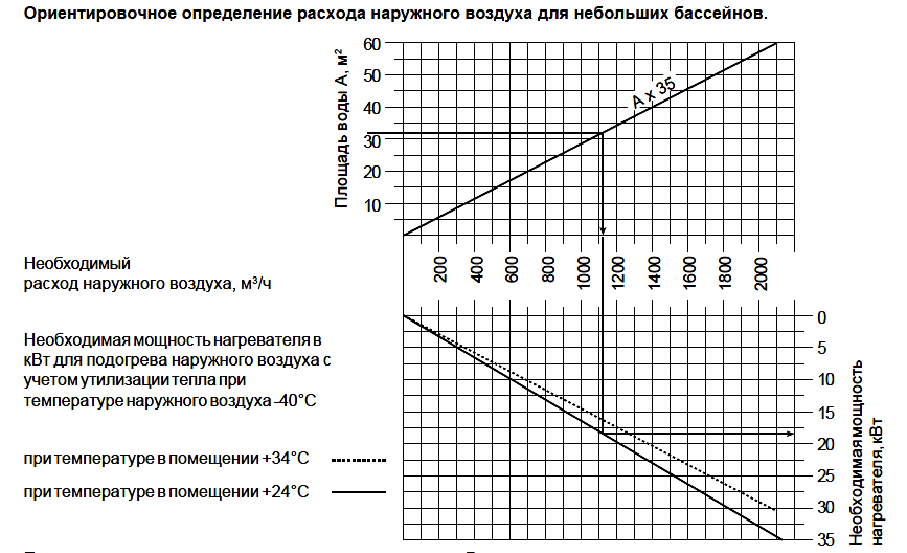
Calculation of pool ventilation.
This parameter will directly depend on the speed of the air flow. Ventilation in the swimming pool of a private house must be organized according to the forced principle. Natural air currents are not always sufficient to ensure that the microclimate is truly favorable.
The noise level should not exceed the level established by law. Most often this value is 60 dB. When choosing machinery and equipment, you must take into account that it must have sufficiently high productivity.
Features of drafting a ventilation system
If you are drafting a ventilation system (regardless of what type it is planned), then you must take into account the functional parameters of the entire structure - this will ensure the specified conditions; also do not forget about the negative factors affecting structural elements. Perhaps the most important substance, without which no pool ventilation is complete, is condensate. If it accumulates on the walls of the ventilation shaft, it will inevitably lead to corrosion processes, as well as equipment failure. To avoid this, it is necessary to insulate the shaft and install electrically heated valves. In addition, be sure to supplement the shaft with a tray into which accumulated moisture would drain.

Any ventilation system (no matter its size) must be able to operate at a lower capacity in order to save electricity when the pool is idle. In turn, you must equip the system with a device of higher power so that the ventilation can cope with everything successfully if there are a large number of people in the pool. Of course, all these additions are not mandatory, but thanks to them, electricity is saved during continuous operation, while the efficiency of the entire system remains at the same level. This addition is especially relevant for country houses, where the equipment is not used as often as, for example, in public swimming pools.
But the most important thing that you should consider during design is the area of the room, the presence/absence of heating, air flow rates, as well as air exchange rates. As for the supply and exhaust system, it can be considered universal, since it is capable of solving all these problems at once. It includes various kinds of structural elements, including fans, filtration devices or, say, a heater. That is why, in fact, she successfully copes with all tasks.

Note! The pool ventilation system should be installed separately from the general house ventilation. We also note that to reduce the evaporation of moisture from the bowl, it can be curtained during downtime.
Project development: features
One of the most important stages in organizing ventilation in the swimming pool of a private house is its design. It is important to take into account all the nuances of the system. When designing, it is necessary to ensure not only effective air exchange between the internal and external environment, but also to exclude the formation of various harmful factors that can adversely affect the human body. One of these is the formation of condensation inside the mine. This may have a detrimental effect on its service life. That is why mines must be insulated. Moreover, this can be done both from the inside and from the outside. Sometimes the system is supplemented with special heating valves. A prerequisite is the use of trays to collect condensate.

Scheme of supply and exhaust ventilation in the pool.
The pool of a private house is a place that is not always actively used by people. That is why at the design stage it is imperative to think about how to save electrical energy. Here everything is implemented quite simply. When the pool is frozen, you do not need to use the equipment at full capacity. It is best to purchase devices that will allow air circulation during non-working periods, but at a minimum level. When a person wants to actively use the pool, he can easily turn on all the available equipment at maximum power. A very convenient way to save energy.
Modern supply and exhaust ventilation can solve several problems at once. It contains several main nodes. It must include: fans, filters and a heater. Additional equipment can also be used. For example, this could be a recuperator. This device allows you to reduce electrical energy consumption by approximately 1/4. Modern swimming pools in private houses use water heating. It is usually located around the entire perimeter of the bowl.
In this case, the ventilation system for the swimming pool of a private house is most often separated from the main one.
We develop a ventilation system project
As noted earlier, when designing ventilation, the air humidity is assumed to be about 65 percent, but in reality this figure is usually reduced by 15 or even 20 percent. The reason for this is extremely simple - the so-called tactile sensation of humidity. So, if the system is equipped correctly and provides the required humidity, then a feeling of discomfort and condensation can still be noticed. As a result, the functional characteristics of the system are adjusted. The phenomena described above disappear after this, but the humidity no longer meets regulatory requirements.
When drawing up a project, also take into account the air flow. There are many formulas and special tables that can help determine the required air exchange at the current temperature and area of the pool bowl.

Here are the main characteristics that must be taken into account during calculations:
- air temperature under the ceiling (due to the fact that warm air weighs less and therefore always tends upward);
- water area;
- number of people visiting the pool at the same time (on average);
- general dimensions of bypass paths;
- air temperature indicator;
- average outdoor temperature in summer/winter;
- temperature indicator of water.
If you design the pool ventilation yourself, then be sure to make the calculations below.
- Determine how much heat comes from people, water in the thicket, sunlight, lighting fixtures and, in fact, paths.
- Determine how much moisture comes from swimmers, paths and water.
- Calculate the air exchange, taking into account the standard indicator.
In accordance with the standards of the German Society of Engineers, the latter indicator must be calculated based on water area, total humidity and water temperature. In addition, the functional features of the room must be taken into account. The calculation formula looks something like this (in kilograms per hour):
e*F*РВ-PL = W.
Let's look at what each of the indicators means:
- F denotes the total water area in square meters;
- PL is the vapor pressure for given humidity/temperature conditions;
- RV is the same steam pressure, but only for the given parameters of the water in the bowl;
- finally, e is an evaporation indicator that determines the functional features of the design.
The last indicator depends on the type of pool. So, if the structure is covered with film, then e will be 0.5; if it has water slides, then 35; if the water is static, then 5; if we are talking about a public swimming pool, then about 20; finally, if the bowl is small and the average number of people attends it, then 15.

Note! Obviously, the humidity outside varies depending on the specific time of year. Professionals recommend taking the average value (it is 9 grams per kilogram), since its change with each subsequent season is not too significant.
We also note that directly when installing a ventilation system, you must thermally insulate and seal each of the air ducts without fail. The air flow should not be directed towards the water surface. If the pool ventilation is small, it can be installed between the base and suspended ceilings. Finally, using an air conditioner in a room that already has ventilation is not advisable.

That's all, now you know what ventilation is in such places, how to design and calculate it. Don't forget to watch another thematic video. Good luck with your work!
Combined (mixed) method
The combined method is chosen for pools with high traffic and a water area of at least 50 m². There is no point in using it for private houses. Ventilation and dehumidification systems can be either independent of each other or combined into a common system. The mixed method is characterized by high installation costs, but low maintenance. It works equally effectively in both warm and cold periods.
We recommend reading: Choosing an air purifier for an apartment
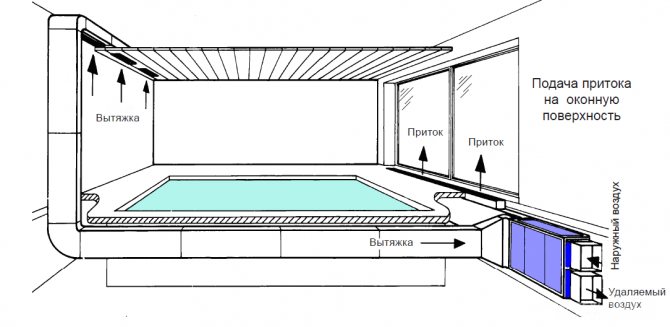
Air handling unit with recuperator and dehumidifier/heat pump
The operating principle of this installation is similar to the previous one, but it is much more efficient in terms of energy consumption. A supply and exhaust unit with heat recovery function can provide optimal air exchange in the pool room. Elimination of unpleasant odors and warm air is carried out by replacing it with fresh air masses, and the recuperator, which is built into the installation, allows you to save energy, since it uses the heat of the exhaust air masses to heat cold air. At the same time, thanks to this design, warm and cold air masses do not mix, and the dehumidifier compressor will need to be turned on in cases where it is necessary to reduce humidity.
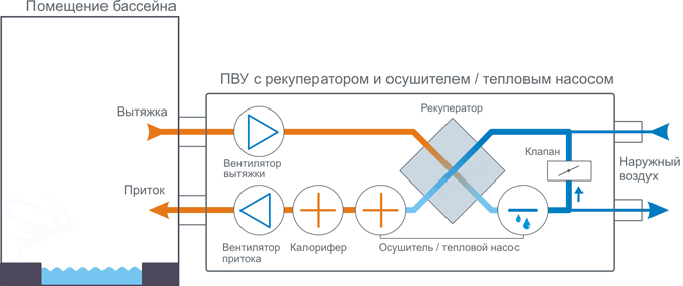
Thus, the use of supply and exhaust ventilation for a swimming pool with a recuperator and a built-in dehumidifier allows maintaining low relative humidity, eliminating discomfort and condensation. In addition, such equipment is the most economical.
